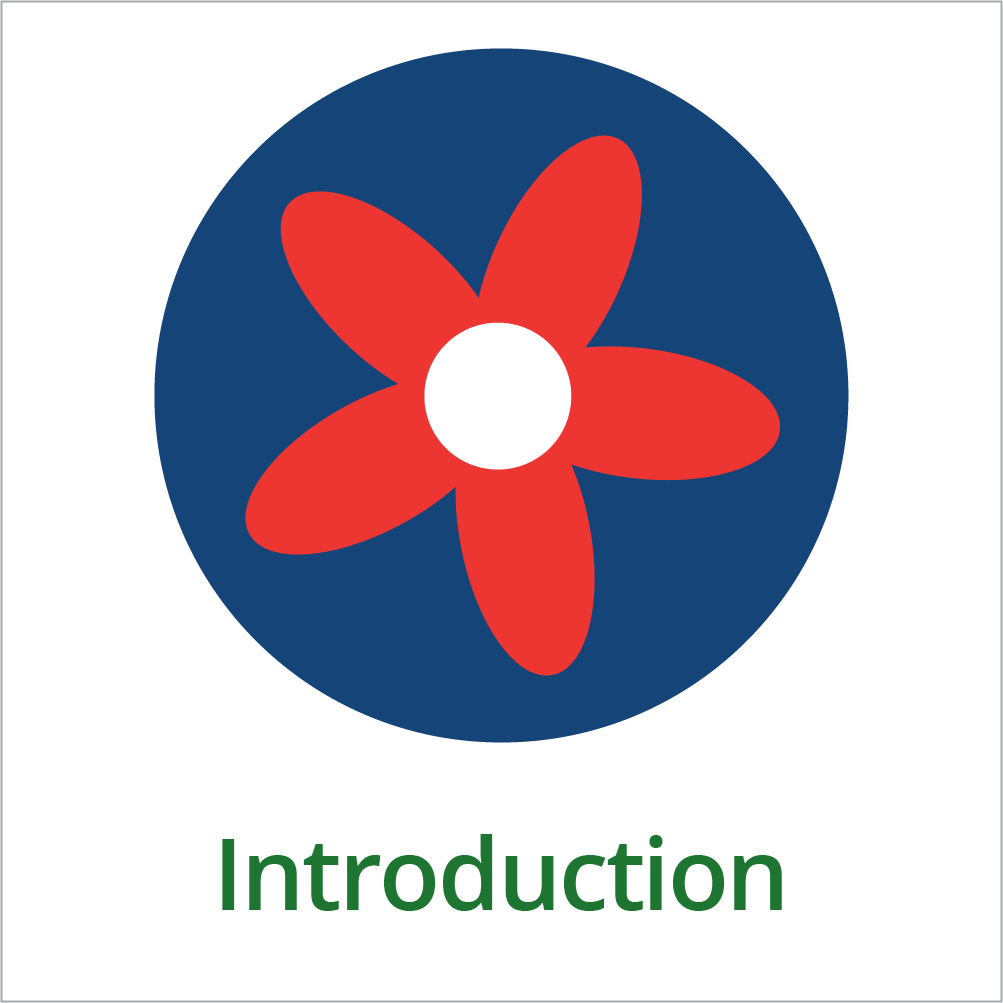The Center for IDEA Early Childhood Data Systems (DaSy Center), funded by the Office of Special Education Programs (OSEP), was charged with developing a data system framework. The purpose of the DaSy Data System Framework (hereafter referred to as DaSy framework) is to assist Part C and Part B 619 programs in developing and enhancing high-quality state data systems for the collection, analysis, reporting, and use of their IDEA data. The DaSy framework is intended to enhance the capacity of Part C and Part B 619 state staff to:
- understand the characteristics and capabilities of a good state data system, so they can
- lead or actively participate in state data system development and enhancement efforts, including cross-agency work, so they can
- use their state data system to comply with IDEA federal reporting requirements and answer important policy and program questions, which will
- enable states to continuously improve their system of services and programs to ensure ready access, high quality services and supports, and positive outcomes for all young children with developmental delays and disabilities and their families served under Part C and Part B 619.
A high-quality data system provides data for multiple purposes. As reflected in the DaSy framework, these purposes are:
- accountability – data are used for federal, state, and local reporting purposes;
- program improvement – data are used to examine and improve programs and services and the results achieved by all young children with disabilities and their families; and
- program operations – data are used to support the day-to-day management and implementation of programs and increase the effectiveness and efficiency of program activities.
Read More +
High-quality data are fundamental to OSEP’s vision for Results-Driven Accountability (RDA), which focuses on using data to improve results for infants, toddlers, children, and youth with disabilities. RDA represents a shift from an accountability system concerned primarily with compliance to one that puts greater emphasis on improving educational results and functional outcomes for children with disabilities and supporting their families. Having high-quality data systems for Part C and Part B 619 programs will improve states’ capacity to collect, analyze, report, and use high-quality data required under the Individuals with Disabilities Education Act (IDEA).
Data-informed decision-making is at the heart of improving the operation of programs and provision of evidence-based practices and supports and, ultimately, of improving results for all children and families. A fundamental assumption reflected throughout the DaSy framework is that Part C and Part B 619 state staff will use data regularly to administer the program and make improvements. High-quality data are instrumental in answering key policy and programmatic questions and developing action plans to address what was learned.
The term data system is conceptualized broadly in the DaSy framework. It refers to the hardware, software, and other applications and processes that enable Part C and Part B 619 programs to collect data about children, families, workforce, and/or program characteristics (e.g., program quality), as well as the analysis, reporting, and data use practices associated with those data. We use the more narrowly defined term of database application to refer to the computer software programs used to enter, store, organize, and retrieve data or information from a computerized database. Database applications allow multiple users to access and use the data, while also securing the data by permitting access by only authorized personnel who can perform various functions with the data, such as entering, querying, updating, and creating data reports.
The DaSy framework was intentionally written to set a high bar for state data systems; a state that has addressed the entire contents of the DaSy Framework will indeed have a high-quality data system. The DaSy framework also was designed to be comprehensive and aspirational. Everything necessary for a high-quality data system is addressed; although we recognize that most states have not yet achieved the entire range of characteristics described in the DaSy framework. A question repeatedly asked during DaSy framework development was, “What does high quality look like?” This question was asked about all facets of the DaSy framework’s broad conceptualization of data systems, including the kinds of data collected, the uses of data, the process and structures for governing the data, and the processes for developing or enhancing the technology.
The Structure of the Framework
Figure 1. Subcomponents of the DaSy Framework
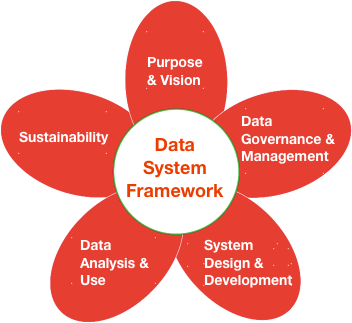
The DaSy framework is organized around five subcomponents: Purpose and Vision, Data Governance and Management, System Design and Development, Data Analysis and Use, and Sustainability (Figure 1). The five subcomponents are interrelated. For example, the Purpose and Vision subcomponent addresses the mission, usage, and goals of the data system, which are fundamental to other subcomponents. The intended uses of data as addressed in the Data Analysis and Use subcomponent should reflect the purpose and vision of the data system and also impact data system design. Similarly, the data system should be designed to reflect the Purpose and Vision and be developed or enhanced in line with the System Design and Development subcomponent. Likewise, Sustainability considerations must be part of and are integral to the Purpose and Vision, Data Governance, and System Design and Development subcomponents.
Read More +
Figure 2. DaSy Framework Subcomponents and the
Life Cycle of a Database Application
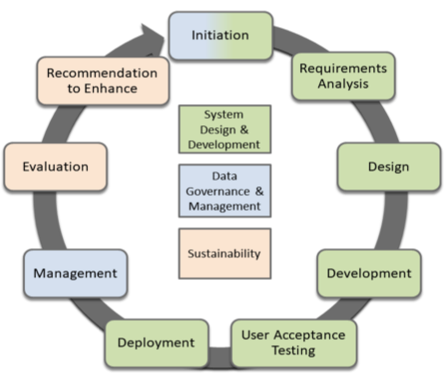
The phases of developing a new data system or enhancing an existing one are commonly viewed as a life cycle (Figure 2), and the DaSy framework subcomponents reflect this. The life cycle model is a high-level view of the major sequential stages a data system goes through. The cycle begins with planning and initiation that reflects the intended Purpose and Vision subcomponent. Next, having a process to identify the need for a new database application or changes to an existing application — for example, user needs for enhancing reporting capability or the need to address a new federal reporting requirement — is addressed in the Sustainability subcomponent. The Data Governance and Management subcomponent addresses the approval to move forward with the change to the data system, the first step in initiating a new system or an enhancement. The phases and processes related to the development of a new system or the enhancement are covered in the System Design and Development subcomponent. The ongoing development and implementation of policies and procedures to manage the data system are part of the Data Governance and Management subcomponent, with the evaluation of how well the system is meeting user needs and recommendation for changes covered in the Sustainability subcomponent.
Figure 3. Structure of the DaSy Framework
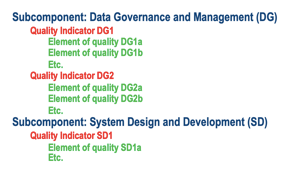
Each of the DaSy framework’s five subcomponents contains one or more quality indicators (QIs) and multiple elements of quality (Figure 3). Quality indicators are broad statements about actions or activities that state agency staff undertake or the policies, procedures, or documents that the state needs to have in place to support a high-quality data system. Each quality indicator has a corresponding set of elements of quality that operationalize the implementation of the quality indicator. The elements of quality describe various aspects of the quality indicator. In short, quality indicators describe what quality is in a data system, and the elements describe how quality is achieved.
Cross-Cutting Themes in the DaSy Framework
Several cross-cutting critical themes are addressed in multiple subcomponents of the DaSy framework. First, data quality is one such theme. Policies and procedures related to data quality are addressed in the Data Governance and Management subcomponent, technical features of the data system to promote data quality are addressed in the System Design and Development subcomponent, and the importance of using data to promote data quality is addressed in the Data Analysis and Use subcomponent.
Read More +
Second, stakeholder engagement is another critical theme because key stakeholders should contribute to each of the subcomponents in certain ways. Members of stakeholder groups may differ depending on the data system topic. Many topics such as the purpose of the data system and uses of the data require input from a broad representation of stakeholders. Other more technical topics such as the development of the business requirements or security features require input from a more limited group of stakeholders. For topics requiring broad stakeholder input, it is essential that the stakeholders fully represent all families, providers, and others who have an interest in the role of data in contributing to a high-quality state system.
Third, an important and aspirational feature of the data system DaSy framework is the emphasis on the integration of the Part C and Part B 619 data with each other and data from other programs serving young children in the state through collaborative data initiatives such as Statewide Longitudinal Data Systems (SLDS) and Early Childhood Integrated Data Systems (ECIDS) (see additional information on pages 6−7). Therefore, elements in several of the subcomponents address the need for states to build early childhood integrated data systems and for Part C and Part B 619 to be a part of these efforts.
Development of the DaSy Framework
Initial Development
Beginning in 2013, the DaSy framework content was developed through an iterative process of literature reviews, information gathering, and multiple rounds of feedback and revisions from state staff in seven partner states and external reviewers. In spring 2013, DaSy invited applications from state Part C and Part B 619 programs interested in working on the development of the DaSy framework. The seven states selected as partners were Alaska, Arkansas, Connecticut, Georgia, Idaho, Massachusetts, and Pennsylvania. The individual staff members from each state were the Part C and 619 coordinators and the Part C and Part B 619 data managers, along with additional personnel from some of the states. The state staff participated in monthly individual state calls and monthly all-state calls. In addition, the state staff participated in four face-to-face meetings between summer 2013 and spring 2014.
Read More +
During this time a work group of DaSy staff members and consultants began developing the quality indicators and elements for each subcomponent with a review of the literature. The work group also developed a set of questions to gather information about the current status of that subcomponent in each partner state. Drawing on the literature and the information collected from the states, the workgroup drafted preliminary quality indicators and elements of quality. These were reviewed by other DaSy staff and revised, shared with the partner states during the all-state and individual state calls, and further revised based on additional input. The face-to-face meetings provided the DaSy staff and partners with the opportunity to engage in more in-depth discussion and refine the DaSy framework content. In the spring of 2014, DaSy staff conducted a series of conference calls with a group of external reviewers (see Acknowledgments) to further refine the content. Final revisions to the first DaSy framework occurred during summer 2014 and included an overall review by OSEP. The framework was released in 2014.
Revisions
In 2020 and 2021, DaSy center staff reviewed and revised the DaSy framework to improve usability. The revision was conducted to improve clarity, streamline content, eliminate redundancy, reduce the number of elements where appropriate, and consolidate indicators and elements within and across subcomponents. As part of this process, stakeholder engagement was eliminated as a separate subcomponent and woven into each of the other subcomponents. This is more aligned with the treatment of stakeholder engagement in the other components of ECTA System Framework and underscores that stakeholder engagement is a cross-cutting theme. The revision process included review and input from state Part C and Part B 619 staff and TA providers who had used the original version of the data system subcomponent and from their colleagues who were less familiar with the previous framework. The intent of the revision was to clarify and, if possible, simplify the critical aspects of a high-quality data system so that states could use the DaSy framework more efficiently and effectively for self-assessment and systems improvement tracking.
Read More +
As noted above, the importance of stakeholder engagement is woven throughout the revised framework. The makeup of the stakeholder groups is a key consideration, and that makeup will differ depending on the specific task addressed in the subcomponent. Regardless of task, for elements addressing stakeholder involvement to be considered to fully implemented, the stakeholders must represent the individuals with a vested interest in the issue. Stakeholder groups involving families must include family representatives reflective of the demographic characteristics of the state. Likewise, stakeholder groups of users involved in reporting data must be representative of those users. To have a high-quality data system, a state must seek out and incorporate input from appropriate individuals for the many different decisions presented across the subcomponents.
Coordination of the Data System (DaSy) Framework with Other Frameworks
Figure 4. ECTA System Framework
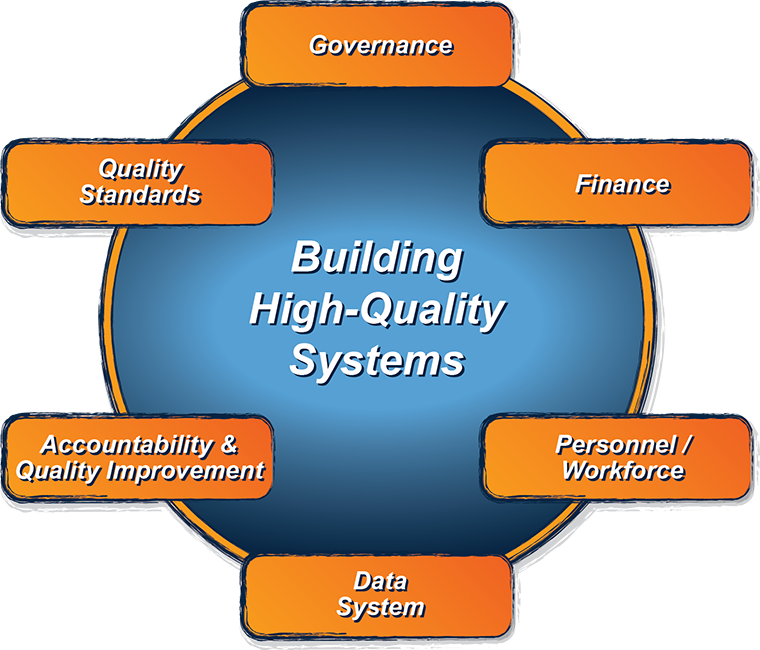
The 2013 DaSy framework was developed in coordination with two other efforts: the Early Childhood Technical Assistance (ECTA) Center’s System Framework and the SLDS State Support team’s framework for data systems. OSEP charged the ECTA Center with developing a framework for high-quality Part C and Part B 619 systems. From the literature and extensive input from six partner states and a technical work group of national, regional, and state experts, ECTA developed a system framework to answer the question, “What does a state need to put into place in order to encourage/support/require local implementation of effective practices that result in positive outcomes for children with disabilities and their families?” The purpose of the ECTA system framework is to guide state Part C and Part B 619 coordinators, staff, and leadership in evaluating their current state Part C and Part B 619 systems and identifying areas for improvement and to provide them with direction on how to develop a more effective, efficient system that supports implementation of effective practices. The ECTA system framework consists of six interrelated components: Governance, Finance, Personnel/Workforce, Data Systems, Accountability and Quality Improvement, and Quality Standards (Figure 4).
Read More +
Because DaSy was tasked with developing a framework for data systems, the two centers agreed that the DaSy data system framework would serve as the Data Systems component in the ECTA framework. Accordingly, the DaSy framework follows the same organizational structure as the ECTA framework (i.e., component, subcomponent, quality indicator, element) to facilitate use by Part C and Part B 619 state staff. The two centers worked closely throughout the initial development of both frameworks to ensure that the DaSy framework was compatible with the other components of the ECTA system framework. Because the DaSy framework was developed on its own in addition to being a component in the ECTA system framework, it has considerably more subcomponents, quality indicators, and elements than the other five components in the ECTA system framework.
DaSy also coordinated with the federal technical assistance project working with states on developing SLDS and ECIDS. Funded by the U.S. Department of Education, in 2012 the SLDS Grant Program State Support Team (SST) worked with states to develop a Toolkit for use when building and implementing an ECIDS. The contents of the Toolkit were organized around the seven components of the SST’s Framework for Data Systems. As the DaSy Center was beginning the development of the DaSy framework, the SST was undertaking development of the Toolkit resources. Recognizing that state staff could be using the DaSy framework to improve their Part C or Part B 619 data system while also using the ECIDS materials to participate in broader collaborative data system initiatives, DaSy committed to making its framework compatible with the ECIDS Toolkit. After discussion with the partner states, DaSy decided to use the same components (e.g., Purpose and Vision, Data Governance) as the SDLS framework. As the work on the DaSy framework progressed, DaSy staff found that the SLDS component Planning and Management was not a good fit with the DaSy framework; management-related topics became part of the Data Governance and Management subcomponent, and planning-related topics became part of the Sustainability subcomponent in the DaSy framework. DaSy and SLDS State Support Team staff compared the contents of each ECIDS component with the comparable DaSy framework subcomponent and identified many similarities and some differences that were deemed necessary given the different purposes of the two frameworks.
In 2020 and early 2021, SLDS State Support Team is also revising their materials associated with ECIDS (for the same purposes described for the DaSy framework revision). DaSy staff have continued to collaborate with SLDS State Support Team staff to ensure the two frameworks are compatible and do not contradict guidance provided to states on similar aspects of high-quality data system development, implementation, maintenance, and enhancement.
Considerations for Understanding and Using the Framework
As states well know, developing a high-quality Part C or Part B 619 data system is a complicated, multifaceted undertaking. The nature and scope of state data systems vary greatly by state. The considerations that follow are important for making the best use of the contents of the DaSy framework.
Read More +
1. What is quality? The operating assumptions for the DaSy framework are as follows:
- A state that has fully implemented all of a quality indicator’s elements has that quality indicator in place.
- A state that has all the quality indicators in the subcomponent in place has high quality in the subcomponent.
- A state that has all the subcomponents in place has a high-quality data system.
Fully implementing an element means that the element is (1) in place and (2) of high quality. For the sake of brevity and because of the extensive variation across states, the DaSy framework does not provide much detail on what constitutes quality implementation for each element. For instance, one of the elements speaks to the need for a state to develop data governance policies with input from stakeholders. The element does not describe what constitutes high- or low-quality stakeholder participation. DaSy has been compiling and developing additional resources for states to further clarify quality at the element level; these resources can be found on the DaSy Center website.
2. Who are Part C and Part B 619 state staff or other state staff? To the extent possible, the quality indicators were written to identify who is expected to carry out the action described in the statement while also being sensitive to the variations in Part C and Part B 619 organization and administration across the states. Therefore, the actors identified in quality indicators and elements are somewhat open ended. When an indicator or element stipulates “Part C/619 state staff” or includes “other staff,” it refers to staff with knowledge of the program and generally refers to the state coordinators or other individuals in the state program office. When an action needs to be carried out specifically by state Part C/619 coordinators, they are identified specifically. When an action is carried out by state leadership this refers to state staff who have authority to make decisions and could include the Part C/619 coordinators, agency leadership, or other leaders.
3. What database applications are included? States have multiple database applications (i.e., a computer software program used to enter, store, organize, and retrieve data or information from a computerized database). States collect multiple types of data related to the implementation of IDEA, and these data may reside in different database applications (Derrington et al., 2013). For example, in many states, data on children reside in one database application whereas information about the personnel who work with them is in another. The information in the DaSy framework applies to every state dataset or application that contain data related to the implementation of IDEA Part C and Part B 619 programs. The phrase “data system” appears many times throughout the DaSy framework. In the interest of succinct communication, the DaSy framework uses “data system” rather than “data systems” or “data system(s).”
4. What are state Part C and Part B 619 data? State Part C/619 data are data related to the implementation of IDEA and encompass different types of data such as data about the children, their families, their services, the providers, and the programs, including the fiscal support for the programs, that serve the children and their families. Included are all the data required for IDEA reporting in the state performance plan/annual performance reports (SPP/APR), the data collections authorized under Section 618 of the IDEA, and other data the state collects about the program. As noted above, some of these data reside in different datasets or databases. Once data are included in the state Part C/619 data system, they are considered part of the Part C/619 state dataset and within the oversight of the state Part C or Part B 619 program, regardless of their origin (e.g., from the local programs or districts).
5. Does the framework apply to local data systems? The DaSy framework was written to identify the components of a high-quality state data system. It is intended to be used by states to examine their state data systems. Many of the quality indicators and elements could apply equally well at the local level, but they were not written or reviewed with local data systems in mind. Local programs are addressed explicitly in the Data Analysis and Use subcomponent because quality data are an essential feature of a good data system, and when data are used by those who provide the data, the quality of the data improves. In addition, the return on investment in collecting the data is maximized when data are used at multiple levels. Also as reflected in the Data Analysis and Use subcomponent, the DaSy framework sees the state as having an important role in supporting programs and districts to use data.
6. Does the framework apply to contractors or vendors? Many of the framework quality indicators and elements are directly applicable to vendors contracted to work with the Part C or Part B 619 program to design, develop, deploy, and/or maintain the database application and other data system functions. However, the framework does not address other important content between the program and vendor typically addressed in a signed contract (e.g., code ownership, transference of data from one vendor to another).
Self-Assessment Tools
The DaSy and ECTA Centers have developed an ECTA/DaSy framework self-assessment based on the ECTA system framework (which includes the DaSy framework as the data system component). The self-assessment enables states to systematically review their status on the framework elements and generates a visual display of that status across quality indicators. The self-assessment is intended to provide states a current snapshot to help them prioritize improvement efforts, generate a set of scores for states to measure progress over multiple points in time, and serve as a mechanism to encourage state participants to engage in rich conversation about their data systems.
The results of the self-assessment can help a state identify the relative strengths and weaknesses of its data system, but the ECTA/DaSy framework is not a road map for how to build a high-quality data system in that it does not tell a state where to start or what to do next. The state will need to determine where to focus improvement efforts based on its priorities and resources. A state might choose to focus entirely on one subcomponent or on elements from multiple subcomponents. A state might choose to complete the self-assessment for only one or two subcomponents. State staff and their stakeholders can use the self-assessment results to support a planning process that identifies the activities, timelines, resources, and outcomes needed to improve the system.
The framework and self-assessment are designed to be tools to help states build high-quality systems of service for infants, toddlers, and preschoolers with developmental delays and disabilities and their families, including high-quality data systems. There are no rules, only suggestions, for how the ECTA/DaSy framework is to be used; therefore, we encourage states to use these tools in whatever ways they find most helpful.
The DaSy and ECTA Centers developed a Framework Quick Start Guide for the initial framework, and this will be revised for the 2022 framework. This guide can help states identify specific subcomponents of the DaSy framework (or components of the ECTA/DaSy framework) for in-depth assessment and improvement planning. Ideally, state leaders would conduct an in-depth review of all components of their system with stakeholder involvement. However, with limited time, state leaders can use this guide as a starting point for their system improvement work.
Uses of and Resources Associated with the DaSy Framework
To date, there have been many uses of the DaSy framework:
- The DaSy Center has used self-assessments with state clients to monitor progress in technical assistance activities with states, to conduct needs assessments, and to evaluate infrastructure improvements.
- The DaSy framework also has been used as a guide to support state system design and development work. Specifically, states have used subcomponents to develop written data governance policies, identify data elements and features of a high-quality data system, or evaluate their data use practices.
- The DaSy Center has used the content of the DaSy framework to guide the development of toolkits about, for example, data governance, building a culture of data use, data visualization, and building stakeholder knowledge about data.
- The DaSy Center also has developed a resource with a set of critical questions that can be addressed with a high-quality data system.
The DaSy Center posts these resources to the DaSy Center website with links to the related part of the DaSy framework.
DaSy Center Technical Assistance Related to the Framework
States can contact the DaSy Center for technical assistance related to the DaSy framework. The DaSy Center can help with finding resources and with improvement activities. We also can clarify the meaning of quality indicators and elements and provide support in using the self-assessment, such as, for example, facilitating a stakeholder process to complete the self-assessment or a strategic planning process to make use of the results.
